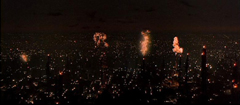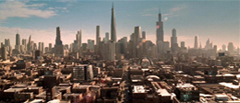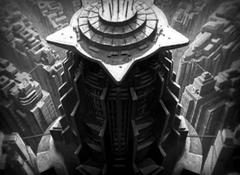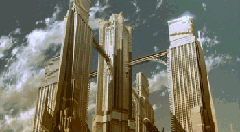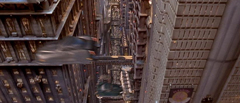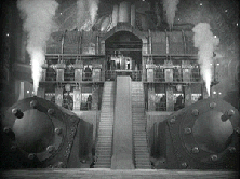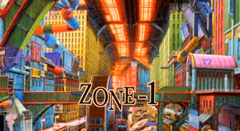
Horizontal expansion is the most common pattern of urban development. A city usually establishes a centroid and then grows outward on the ground plane from this point. The extreme scenario of this growth pattern is depicted in Blade Runner. The pyramidal Headquarters of the Tyrell Corporation is the centroid and urban environment seems to have sprawled outward from this point in a chaotic fashion. The outward expansion seems endless since no periphery is stated.
The upward growth of urban environments initiated with advances in the fabrication and application of steel. In the history of the development of most cities, an upward race to claim ownership to the tallest tower has ensued. The intrigue of the tallest structure is its symbolism of the centre and being the top of the hierarchy of power within the metropolis. This idea is carried forward in all the films; the Tyrell Corporation Headquarters in Blade Runner, the tower of Zorg in The Fifth Element, the USR corporation tower in I-Robot, and the tower of authority in Metropolis 1927 and 2001. Most major cities in the world have their cultural and economic nucleus marked by a cluster of high-rise towers. New York on the other hand, is a unique urban environment because the whole island is virtually a cluster of high-rise towers. The Fifth Element takes this urban development to the next level. As opposed to series of point towers stemming from the ground plane, buildings are built on top of existing buildings. The consequence is that only the upper most structures have access to light and space. The condition of the buildings becomes progressively worse towards the lower regions of the more distant past. The condition is so severe in the movie that the ground has reversed from the most active plane of public use to desolate and unviable level. This urban form is uncanny because it makes one feel lost. The appeal of the classical point tower is the privilege of the high vantage point that allows you to look over the city and orientate your position relative to it. In The Fifth Element, the opposite condition is presented. For the most part, the audience experiences the urban environment at a midway point in its height, not knowing the location of the top nor bottom. The viewer is stranded within a vertical world with only a few transfer points. The disorientation and immobility of the scenario is uncomfortable.
Subterranean growth is something fairly new and not extensively pursued in the contemporary world. The idea is brought forward in the 1927 version of Metropolis and carried out in greater detail and extent in the 2001 release. In both films, the subterranean environment houses the working class and the less attractive machinery required for the proper functioning of the metropolis. In the 1927 version, the subterranean environment is dark and unpleasant, clearly a place of the less privileged. In the later version, the same is true for zone 2 and zone 3, which host the power generating machinery and waste management facilities respectively. Subterranean level one is actually quite provocative since it is open to above, allowing natural light to penetrate. It plays a significant role in the public domain, being the housing level and the stage of many festivities. While this environment is comfortable the lower levels create the opposite effect because they catalyze feelings of disorientation and entrapment.
The feelings
of the uncanny generated by the urban forms become progressively more
severe from the traditional horizontal form to the point tower to the
subterranean environment.







